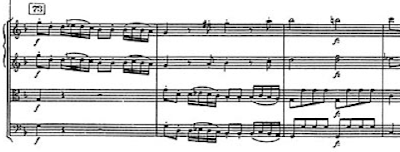Let's see how this works in the Symphony No. 79, written in 1784. It opens with a crisp eight measure period:
 |
| Click to enlarge |
Notice how the rhythm is what gives this motif its character and how much energy is contained in the rhythm (the articulation of staccato and legato also contributes). In the development Haydn gives this motif a contrapuntal treatment:
This is completely unlike the counterpoint a Baroque composer would have used. Again, it is about rhythm and specifically blocks of rhythm alternating. In the Baroque they would have overlapped, for continuity rather than contrast. Later on in the development Haydn fragments just the little sixteenth-note motif from the first theme:
Again, notice how this is very much a rhythmic device.
The second movement begins as an Adagio, but this theme also has a lot of rhythmic activity:
| Click to enlarge |
| Click to enlarge |
The Wikipedia author(s) of the article on this symphony can't see any connection, but these two themes have a very close family resemblance, especially in the fourth measure.
The minuet and trio continue with the rhythmic clarity and balanced phrases:
This continues with the last movement, a vivace in rondo form. Notice how the theme is rhythmically energetic, but clear and focused:
 |
| Click to enlarge |
Also notice how well the accompaniment is crafted to impel the theme forward: the violas and cellos emphasize the downbeat while the second violin provides the effervescence. Notice too how each four measure group is rounded off by a cadence formula and eighth notes in the violas and cellos. It looks simple, but everything is very carefully integrated to create one effect. Haydn is much less angular and asymmetrical than he used to be. I believe that every theme in this symphony is an eight measure phrase.
Now let's listen to a performance. Here is Christopher Hogwood and the Academy of Ancient Music:







No comments:
Post a Comment